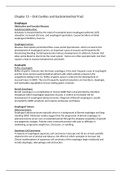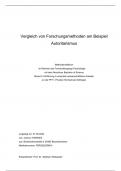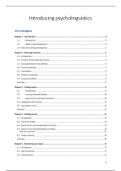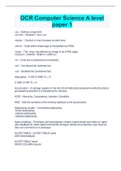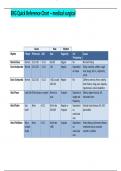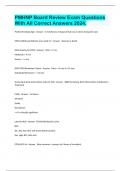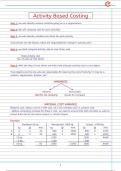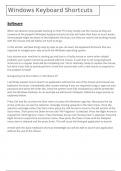Chapter 15 – Oral Cavities and Gastrointestinal Tract
Esophagus
Obstructive and Vascular Diseases
Functional obstruction
Achalasia is characterized by the triad of incomplete lower esophageal sphincter (LES)
relaxation, increased LES tone, and esophageal aperistalsis. Caused by failure of distal
esophageal inhibitory neurons.
Esophageal varices
Diseases that impede portal blood flow cause portal hypertension, which can lead to the
development of esophageal varices, an important cause of massive and frequently life-
threatening bleeding. Portal hypertension induces development of collateral channels that
allow portal blood to shunt into the caval system. Varices are often asymptomatic, but their
rupture a lead to massive hematemesis and death.
Esophagitis
Reflux esophagitis
Reflux of gastric contents into the lower esophagus is the most frequent cause of esophagitis
and the most common gastrointestinal ailment with which patients present in the
outpatients setting in the US. Reflux of gastric juices is central to the development of
mucosal injury in GERD. The most frequently reported symptoms are heartburn, dysphagia,
and noticeable regurgitation of sour-tasting gastric contents.
Barrett Esophagus
Barrett esophagus is a complication of chronic GERD that is characterized by intestinal
metaplasia within esophageal squamous mucosa. It confers an increased risk for
development of esophageal adenocarcinoma. Diagnosis of Barrett esophagus is usually
prompted by GERD symptoms and requires endoscopy and biopsy.
Esophageal Tumors
Adenocarcinoma
Esophageal adenocarcinoma typically arises in a background of Barrett esophagus and long-
standing GERD. Molecular studies suggest that the progression of Barrett esophagus to
adenocarcinoma occurs over an extended period through the stepwise acquisition of genetic
and epigenetic changes. Patients most commonly present with pain or difficulty in
swallowing, progressive weight loss, chest pain, or vomiting.
Squamous Cell Carcinoma
A majority of esophageal squamous cell carcinomas in Europe and US are at least partially
related to the use of alcohol and tobacco, the effect of which synergize to increase risk.
Clinical manifestations of squamous cell carcinoma of the esophagus begin insidiously and
include dysphagia, odynophagia and obstruction.
, Stomach
Gastropathy and acute gastritis
Gastritis results from mucosal injury. When neutrophils are present, the lesion is referred to
as acute gastritis. When cell injury and regeneration are present but inflammatory cells are
rare or absent, the term gastropathy is
applied. Both gastropathy and acute
gastritis may be asymptomatic or
cause variable degrees of epigastric
pain, nausea, and vomiting. In more
severe cases, there may be mucosal
erosion, ulceration, hemorrhage,
hematemesis, melena, or massive
blood loss. Main causes include:
NSAIDs inhibit COX-dependent
synthesis of prostaglandins E2
and I2, which stimulate nearly
all defense mechanisms
Gastric injury that occurs in
uremic patients and those infected with urease-secreting H. pylori may be due to
inhibition of gastric bicarbonate transporters by ammonium ions.
Reduced mucin and bicarbonate secretion increased susceptibility of adults
Hypoxemia and decreased oxygen delivery increased incidence of gastropathy and
acute gastritis
Ingestion of harsh chemicals severe gastric mucosal damage
Stress-Related Mucosal Disease
Stress-related gastric injury occurs in patients with severe trauma, extensive burns,
intracranial disease, major surgery, serious medical disease, forms of severe physiologic
stress.
Stress ulcers critically ill patients
Curling ulcers proximal duodenum and associated with severe burns of trauma
Cushing ulcers stomach, duodenum or esophagus with intracranial disease and
high incidence of perforation.
The pathogenesis of stress-related gastric mucosal injury is most often due to local ischemia.
This may be caused by systemic hypotension or reduced blood flow resulting from stress-
induced splanchnic vasoconstriction. Ulcers are associated with nausea, vomiting, melena,
and coffee-ground hematemesis.
Chronic gastritis
The most common cause of chronic gastritis is infection with the bacillus Helicobacter pylori.
The signs and symptoms associated with chronic gastritis typically are less severe but more
persistent than those of acute gastritis.
Helicobacter Pylori gastritis
The discovery of the association of H. pylori with peptic ulcer disease revolutionized the
understanding of chronic gastritis. In the US, H. pylori infection is associated with poverty,
household crowding, limited education, residence in areas with poor sanitation, and birth
Esophagus
Obstructive and Vascular Diseases
Functional obstruction
Achalasia is characterized by the triad of incomplete lower esophageal sphincter (LES)
relaxation, increased LES tone, and esophageal aperistalsis. Caused by failure of distal
esophageal inhibitory neurons.
Esophageal varices
Diseases that impede portal blood flow cause portal hypertension, which can lead to the
development of esophageal varices, an important cause of massive and frequently life-
threatening bleeding. Portal hypertension induces development of collateral channels that
allow portal blood to shunt into the caval system. Varices are often asymptomatic, but their
rupture a lead to massive hematemesis and death.
Esophagitis
Reflux esophagitis
Reflux of gastric contents into the lower esophagus is the most frequent cause of esophagitis
and the most common gastrointestinal ailment with which patients present in the
outpatients setting in the US. Reflux of gastric juices is central to the development of
mucosal injury in GERD. The most frequently reported symptoms are heartburn, dysphagia,
and noticeable regurgitation of sour-tasting gastric contents.
Barrett Esophagus
Barrett esophagus is a complication of chronic GERD that is characterized by intestinal
metaplasia within esophageal squamous mucosa. It confers an increased risk for
development of esophageal adenocarcinoma. Diagnosis of Barrett esophagus is usually
prompted by GERD symptoms and requires endoscopy and biopsy.
Esophageal Tumors
Adenocarcinoma
Esophageal adenocarcinoma typically arises in a background of Barrett esophagus and long-
standing GERD. Molecular studies suggest that the progression of Barrett esophagus to
adenocarcinoma occurs over an extended period through the stepwise acquisition of genetic
and epigenetic changes. Patients most commonly present with pain or difficulty in
swallowing, progressive weight loss, chest pain, or vomiting.
Squamous Cell Carcinoma
A majority of esophageal squamous cell carcinomas in Europe and US are at least partially
related to the use of alcohol and tobacco, the effect of which synergize to increase risk.
Clinical manifestations of squamous cell carcinoma of the esophagus begin insidiously and
include dysphagia, odynophagia and obstruction.
, Stomach
Gastropathy and acute gastritis
Gastritis results from mucosal injury. When neutrophils are present, the lesion is referred to
as acute gastritis. When cell injury and regeneration are present but inflammatory cells are
rare or absent, the term gastropathy is
applied. Both gastropathy and acute
gastritis may be asymptomatic or
cause variable degrees of epigastric
pain, nausea, and vomiting. In more
severe cases, there may be mucosal
erosion, ulceration, hemorrhage,
hematemesis, melena, or massive
blood loss. Main causes include:
NSAIDs inhibit COX-dependent
synthesis of prostaglandins E2
and I2, which stimulate nearly
all defense mechanisms
Gastric injury that occurs in
uremic patients and those infected with urease-secreting H. pylori may be due to
inhibition of gastric bicarbonate transporters by ammonium ions.
Reduced mucin and bicarbonate secretion increased susceptibility of adults
Hypoxemia and decreased oxygen delivery increased incidence of gastropathy and
acute gastritis
Ingestion of harsh chemicals severe gastric mucosal damage
Stress-Related Mucosal Disease
Stress-related gastric injury occurs in patients with severe trauma, extensive burns,
intracranial disease, major surgery, serious medical disease, forms of severe physiologic
stress.
Stress ulcers critically ill patients
Curling ulcers proximal duodenum and associated with severe burns of trauma
Cushing ulcers stomach, duodenum or esophagus with intracranial disease and
high incidence of perforation.
The pathogenesis of stress-related gastric mucosal injury is most often due to local ischemia.
This may be caused by systemic hypotension or reduced blood flow resulting from stress-
induced splanchnic vasoconstriction. Ulcers are associated with nausea, vomiting, melena,
and coffee-ground hematemesis.
Chronic gastritis
The most common cause of chronic gastritis is infection with the bacillus Helicobacter pylori.
The signs and symptoms associated with chronic gastritis typically are less severe but more
persistent than those of acute gastritis.
Helicobacter Pylori gastritis
The discovery of the association of H. pylori with peptic ulcer disease revolutionized the
understanding of chronic gastritis. In the US, H. pylori infection is associated with poverty,
household crowding, limited education, residence in areas with poor sanitation, and birth



